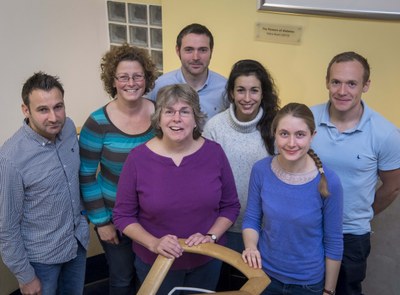Hirst, J.*, Hesketh, G.G., Gingras, A.-C., and Robinson, M.S.* 2021.
Rag GTPases and phosphatidylinositol 3-phosphate mediate recruitment of the AP-5/SPG11/SPG15 complex. J. Cell Biol. 220(2):e202002075 *Joint corresponding authors
Davies, A.K., Itzhak, D.N., Edgar, J.R., Aechuleta, T.L., Hirst, J., Jackson, L.P., Robinson, M.S.*, and Borner, G.H.H.*. 2018. AP-4 vesicles contribute to spatial control of autophagy via RUSC-dependent peripheral delivery of ATG9A. Nat. Commun. 9: 3958.
*Joint corresponding authors
Hirst J, Itzhak DN, Antrobus R, Borner GHH & Robinson MS. Role of the AP-5 adaptor protein complex in late endosome-to-Golgi retrieval. PLoS Biol. 16: e2004411 (2018).
Navarro Negredo P, Edgar JR, Manna PT, Antrobus R & Robinson MS. 2018. The WDR11 complex facilitates the tethering of AP-1-dervied vesicles. Nature Comm. 9: 596 (2018).
Navarro Negredo P, Edgar JR, Wrobel AG, Zaccai NR, Antrobus R, Owen DJ & Robinson MS. Contribution of the clathrin adaptor AP-1 subunit µ1 to acidic cluster protein sorting. J. Cell Biol. 216, 2927-2943 (2017).
Edgar JR, Manna PT, Nishimura S, Banting G & Robinson MS. Tetherin is an exosomal tether. eLife 5: e17180 (2016).
Hirst J, Edgar JR, Borner GHH, Li S, Sahlender DA, Antrobus R & Robinson MS. Contributions of epsinR and gadkin to clathrin-mediated intracellular trafficking. Mol. Biol. Cell 26, 3085-3103 (2015).
Hirst J, Edgar JR, Esteves T, Darios F, Madeo M, Chang J, Roda RH, Dürr A, Anheim M, Gellera C, Li J, Züchner S, Mariotti C, Stevanin G, Blackstone C, Kruer MC & Robinson MS. Loss of AP-5 results in accumulation of aberrant endolysosomes: defining a new type of lysosomal storage disease. Hum. Mol. Genet. 24, 4984-4996 (2015).
Hirst J, Schlacht A, Norcott JP, Traynor D, Bloomfield G, Antrobus R, Kay RR, Dacks JB & Robinson MS. Characterization of TSET, an ancient and widespread membrane trafficking complex. eLife 3: e02866 (2014).
Borner GHH, Hein MY, Hirst J, Edgar JR, Mann M & Robinson MS. Fractionation profiling: a fast and versatile approach for mapping vesicle proteomics and protein-protein interactions. Mol. Biol. Cell. 25: 3178-3194 (2014).
Kozik P, Hodson NA, Sahlender DA, Simecek N, Soromani C, Wu J, Collinson LM & Robinson MS. A human genome-wide screen for regulators of clathrin-coated vesicle formation reveals an unexpected role for the V-ATPase. Nature Cell Biol. 15, 50–60 (2013).
Borner GHH, Antrobus R, Hirst J, Bhumbra GS, Kozik P, Jackson LP, Sahlender D A & Robinson MS. Multivariate proteomic profiling identifies novel accessory proteins of coated vesicles. J. Cell Biol. 197, 141–160 (2012).




